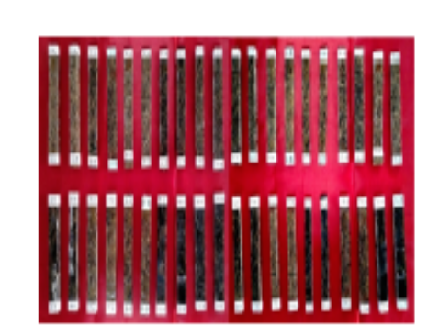


Indian Journal of Science and Technology
DOI: 10.17485/IJST/v16i42.2327
Year: 2023, Volume: 16, Issue: 42, Pages: 3829-3837
Original Article
N Raja1*, S Raju1
1Department of Manufacturing Engineering, Faculty of Engineering and Technology, Annamalai University, Annamalainagar, 608 002, Tamil Nadu, India
*Corresponding Author
Email: [email protected]
Received Date:13 September 2023, Accepted Date:05 October 2023, Published Date:13 November 2023
Objective: In recent years, researchers have paid more attention to using natural fibres rather than synthetic glass fibres when manufacturing polymer matrix composites. Therefore, the current study focuses on fabricating and optimizing the parameters for maximizing the Flexural Strength (FS) of an epoxy composite reinforced with Bismarck Palm Fibre (BPF) and Cashew Friction Dust (CFD) particles. Methods: The water retting technique was used to extract the BPF from leaf stalk of Bismarck palm tree. The composites were fabricated by hand lay-up method. The process parameters for the research were Fibre Length (FL), Volume Fraction (VF), and CFD particle size (CFD). The experiments were developed using the Central Composite Design (CCD) method. The significance of process parameters on output response of the FS was examined using the response surface methodology (RSM). Using a scanning electron microscope (SEM), the fractured surface of the flexural specimen was examined. Findings: The results demonstrated that the optimal parameter conditions for flexural strength were a fibre length of 22 mm, a fibre volume fraction of 24%, and CFD particle sizes of 300 μm. The optimal flexural strength of the produced composite is 46.60 MPa. The most important fabrication parameters that affects the flexural strength of epoxy composites reinforced with BPF and CFD particles is known as the fibre volume fraction. The SEM images showed the various failure mechanisms such as fibre breakage, fibre tear, fibre pull out, fibre/matrix bonding, and matrix breakage. Novelty: This research is evidence that BPF and CFD reinforced epoxy composites have higher flexural strength compared to other natural fibres reinforced composites such as date palm fibres, sugar palm fibres, and date palm sheath fibres reinforced composites. The optimal parameter conditions obtained for fabricating epoxy composites reinforced with BPF and CFD particles could be used for further research.
Keywords: Bismarck palm fibre, Cashew friction dust particles, Epoxy, Optimization, Flexural strength
© 2023 Raja & Raju. This is an open-access article distributed under the terms of the Creative Commons Attribution License, which permits unrestricted use, distribution, and reproduction in any medium, provided the original author and source are credited. Published By Indian Society for Education and Environment (iSee)
Subscribe now for latest articles and news.